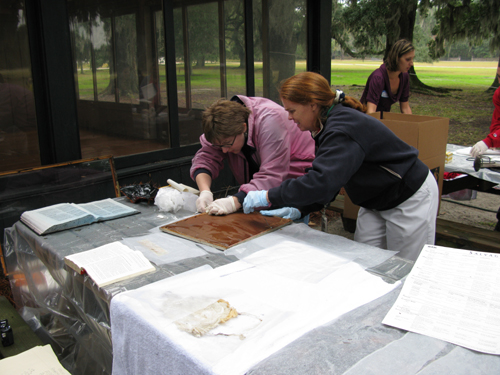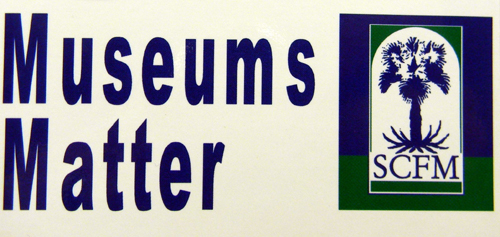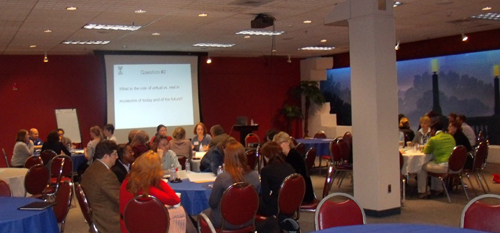The museum profession is constantly changing. New standards for collections care, exhibition design, curatorial research, digitization of information, use of social media, educational programming, membership tracking, and every other aspect of museum work are being discussed daily on list-servs, blogs, and at various gatherings of museum professionals. Museum staff need high levels of knowledge and expertise to continue to add value to the communities they serve. Conferences and relevant workshops provide opportunities for peer engagement, expansion of one’s knowledge base, and information that can be put into practice immediately. In South Carolina, one important resource for professional development opportunities is the South Carolina Federation of Museums (SCFM), founded in 1970. Today, SCFM continues to support its mission to serve, represent, advocate, and promote the best interests of South Carolina museums through professional development, public relations, advocacy, and other services.

For the past year I have served as Chair of the SCFM Professional Development Committee (PDC). Each year, this Committee plans the Federation’s annual conference. I worked with a group of eight individuals from museums and historic sites across the state to organize the two-day event. As many people know, volunteer committee work can be interesting, challenging and rewarding. An assortment of people who do not know each other well are expected to quickly figure out their strengths, weaknesses, and working styles to accomplish big goals. The PDC Committee met four times over the course of the year to plan the conference. Efficiency, open communication and the ability to adapt were essential during the planning process. I learned so much about leadership, group dynamics, and how to delegate instead of micro-manage. While there are aspects of committee work in my position at the Gibbes, event planning was new territory for me. I took every opportunity to ask questions and learn from others even though I was technically in charge.

The conference occurred in March in Columbia, South Carolina and offered an array of educational sessions, workshops, tours and networking events around the theme, Museums Matter. A session called Group Think: The South Carolina Experiment was a new addition to the 2011 conference. The idea came from the American Association of Museum’s Center for the Future of Museums (CFM), an organization that facilitates creative discussions and events to assist museums in “transcending traditional boundaries to serve society in new ways.” One of CFM’s projects is called Voices of the Future, an international, interdisciplinary discussion about the future of museums and society in which a series of questions are posed and the answers shared via YouTube.
We decided to try this type of informal discussion that allowed participants to interact while considering the future of the profession. We had close to fifty people attend the session. Participants were grouped by their positions (curators, educators, development and membership coordinators, administrators, etc.) and asked to consider three questions about the future of museums. The resulting discussions were lively and interesting. Educators were particularly animated while curators had quiet, thoughtful conversations. Registrars were (of course) very organized with their answers and administrators focused on broad themes that will impact all future museums. Below are the questions and a recap of the answers that resulted from Group Think.

#1. What are the most important trends in society that will shape museums in the next 25 years?
All groups noted that technology was a major trend which will shape the future of museums. Educators also highlighted the lack of public financing and teacher accountability/student achievement as factors that will impact their role in museums. Administrators focused on nostalgia as a future trend. Curators discussed the effect of a global economy, social networking, and a museum’s ability to offer different points of access to its holdings as influential factors. The marketing group talked about technology and advertising opportunities, and registrars highlighted environmental awareness as a trend that will continue to effect museums and collections.
#2. What is the role of virtual vs. real in museums of today and of the future?
Participants recognized that virtual experiences should continue to be used as a means to generate interest in viewing the real thing (painting, artifact, specimen, etc.). Educators noted that online activities are useful tools for supplementing museum experiences while administrators pointed out that they do exclude some demographics. Curators discussed how the virtual experiences allow broad access to museum collections and noted diverse delivery methods are also beneficial. Marketing professionals felt that local history should be used to make connections in a larger context. Registrars focused on how virtual access to original artifacts might evolve in the future.
#3. What is the future of the economics of running and supporting a museum?
Partnerships were a common theme during this discussion. Those seated at the education table stressed alternative revenue streams such as facility rentals but noted the possible impacts on a museum’s programs and mission. Administrators discussed the need to diversify funding and reduce dependence on government support and grants. Curators talked about grass roots advocacy and strategies to actively demonstrate a museum’s value to the community it serves. Marketers highlighted the need to cultivate 20–40 year olds (“grow” future donors) and position museums as a gathering place with consistent, appealing programming. Registrars focused on the need for a clear, organized plan for any project that requires additional funds.
To close the session, the entire group discussed what had been learned. Attendees agreed that the current cultural majority will change over the next twenty-five years. Museums should continue to monitor and acknowledge the changes and adapt accordingly. It was also noted that young professionals will be essential to providing input and bridging the gap between past museum philosophies and expectations of future audiences. Overall, those that attended Group Think found the experience beneficial and asked for future opportunities, virtual or real, to continue these discussions. The afternoon provided food for thought on how we can be more effective in our jobs, improve our institutions, strengthen the field and communicate the value of our museum in the future.
While my year as PDC Chair is coming to a close, I will continue to be actively involved with the South Carolina Federation of Museums and other professional museum groups. I have organized a workshop called Leadership Training for Museums Professionals which will be held in Charleston this week (May 11) and I am looking forward to presenting a session at the 2011 American Association of Museums Annual Meeting in Houston. Later this year, I will also be present a session at the Southeastern Museums Conference in Greenville, SC. The Gibbes Museum of Art has been extremely supportive of my involvement in professional organizations and I hope to continue to represent the Gibbes, Charleston, and the South Carolina at museum conferences at the state, regional, and national levels.
—Zinnia Willits, Director of Collections Administration, Gibbes Museum of Art
Published May 9, 2011

